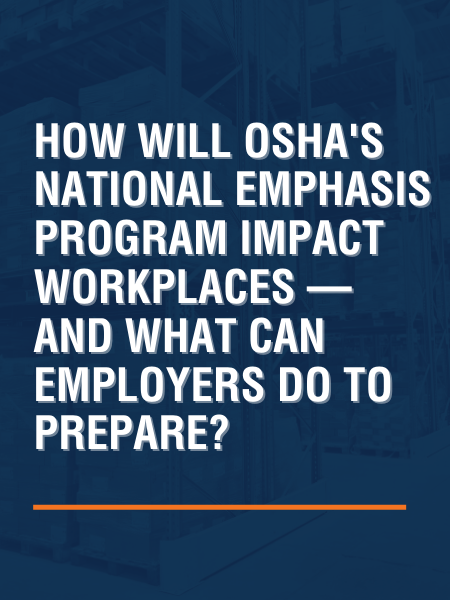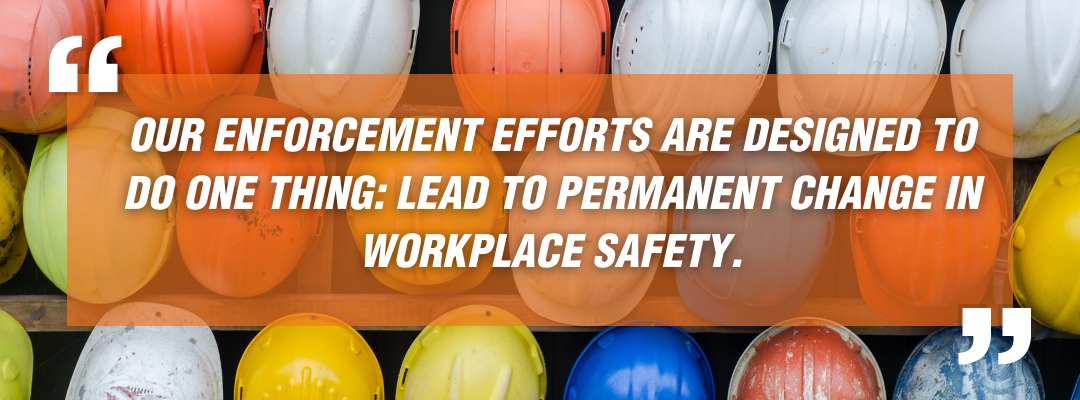We use cookies to make your experience better. To comply with the new e-Privacy directive, we need to ask for your consent to set the cookies. Learn more.
The OSHA National Emphasis Program for Warehouses: What Operators Should Know

The Occupational Safety and Health Administration (OSHA) has announced a national program geared towards warehouses, processing facilities, distribution centers, and high-risk retail establishments.
The three-year program is intended to reduce hazards by increasing inspections for compliance with existing standards.
"This emphasis program allows OSHA to direct resources to establishments where evidence shows employers must be more intentional in addressing the root causes of worker injuries and align their business practices with the goal to ensure worker health and safety," said Doug Parker, assistant secretary for OSHA, in a press release announcing the program.
For operators, there’s an obvious question: How will the national emphasis program impact workplaces — and what can employers do to prepare?
OSHA Will Conduct Comprehensive Warehouse Safety Inspections
OSHA’s press release outlines several key areas of compliance, which will receive renewed focus during the program’s three-year period. The raw number of inspections will increase, and the scope of those inspections may expand if inspections find violations in other areas of the establishment.
The hazards covered by the inspections will include:
- Powered industrial vehicle operations.
- Material handling and storage.
- Walking and working surfaces.
- Means of egress and fire protection.
- Heat and ergonomic hazards.
Of course, many OSH inspections are conducted by state agencies — but states will be required to adopt the emphasis program “or establish a different program at least as effective" as the federal plan.
How Will OSHA Determine Which Warehouses Will Be Inspected?
OSHA will use two lists to select establishments for inspection.
The first list is made up of all organizations with industry codes covered under the program (including most warehouses and distribution centers). The second list consists of retail establishments with relatively high rates of injuries and illnesses.
In other words, if you operate a warehouse or distribution center, you may anticipate a higher rate of inspections conducted through either the federal or state OSH plans.
Preparing for OSHA Warehouse Inspections: 3 Keys
For the vast majority of organizations, the prospect of rigorous OSHA inspections isn’t exactly good news. However, on-the-job injuries are certainly an issue in the warehousing and logistics industries: Data from the Bureau of Labor Statistics shows that injury and illness rates are higher for these businesses than in private industry overall.
And injuries are expensive. U.S. employers pay an estimated $1 billion per week for direct workers' compensation costs — a figure that doesn’t include lost productivity, re-training, and other expenses that occur when a worker can’t do their job.
Ultimately, safe facilities tend to be productive facilities. OSHA’s national emphasis program should compel employers to recognize the value of a safe workplace — and make relevant investments to support their workers.
Here are a few ways to promote OSHA workplace safety (and prepare your establishment for an inspection).
1. Focus On Lift Trucks and Battery Rooms.
In 2021 alone, 70 workers suffered fatal injuries in forklift accidents. As many as 62,000 injuries occur every year involving lift trucks, and those injuries are largely preventable.
OSHA has focused on forklift safety in recent years, announcing a proposed rule to update its general industry and construction standards for powered industrial trucks by incorporating American National Standards Institute (ANSI) requirements.
But existing OSHA standards provide employers with pages of actionable guidance for utilizing lift trucks safely. Your hazard assessment should focus on material handling equipment (MHE), and since lift trucks are in regular use in most warehouses, they’re an obvious place to start.
Forklift injuries can often be prevented by establishing clear travel paths, and through employee training. Below, we’ve linked several articles that address the finer points of OSHA-compliant forklift operation:
- OSHA Guidelines for Forklift Traffic on Dock Ramps and Yard Ramps
- OSHA Standards for Industrial Work Platforms Mounted on Forklifts
- Managing the Forklift Center of Gravity, According to OSHA
If your facility uses electric forklifts, the battery room is another obvious point of concern. Battery rooms must be properly outfitted with emergency stations, and employees must understand safe procedures for adding water, rinsing batteries, and responding to spills. Appropriate ventilation and hydrogen monitoring are also essential for compliance.
Some resources:
- Battery Room Regulations and OSHA Battery Charging Requirements
- Battery Room Ventilation Code Requirements
- The HVAC Industry Guide to Forklift Battery Room Ventilation Systems
- Watering Forklift Batteries: The Complete Guide for Battery Room Operators
OSHA inspections prioritize “imminent danger situations,” and improper lift truck operation (or poorly designed battery rooms) can certainly fall into that category. Audit your facility for hazards, train employees, and look for opportunities to remove hazards — either by upgrading equipment or changing work processes.
2. Look for Opportunities to Enforce Good Ergonomics.
OSHA’s announcement of the national emphasis program mentions ergonomics, which are enforceable under the General Duty Clause of the OSH Act.
Of course, great ergonomics are great for business. Awkward positioning, heavy lifting, and repetitive motions mean poor throughput — and if you can design the task to fit the worker, you’ll improve productivity while preventing a common source of on-the-job injuries.
The OSH General Duty Clause simply requires employers to implement “realistic methods'' to eliminate or reduce severe ergonomic hazards. If you make a good-faith effort to recognize and address hazards, you’re on the right track. Some tips:
- Audit your work processes for tasks that require heavy lifting, bending, twisting, reaching, and other unnatural body movements. Read: 4 Common Ergonomic Hazards in Warehouses.
- Address each hazard individually. Look for ways to eliminate unnatural movements. For example, by installing tilt tables, you can reposition loads for packing and unpacking, putting the work at an appropriate angle for the employee.
- For specialized tasks, consider custom material handling equipment.
- Train employees to use ergonomic movements. For additional guidance, read: Ergonomics in Material Handling.
If you need to build a business case for ergonomic equipment in the warehouse, these resources may be helpful:
- How Better Warehouse Ergonomics Improves Productivity
- How Warehouse Ergonomics Can Help You Cope with Labor Shortages
- Retaining Warehouse Staff with Ergonomic Equipment
3. Communicate Risks and Hazards to Employees.
OSHA compliance begins with appropriate MHE outfitting, but it ends with the employee. Clear signage should be used to communicate risks and rules, particularly in areas where employees work with chemical hazards (such as battery rooms).
Learn the best practices for battery room signage, following standards from OSHA, the National Fire Protection Agency (NFPA) and other institutions.
In addition to signage, you should hold robust training (and re-training) sessions. Document training and ensure that you’re following OSHA’s rules for periodic retraining.
Additional guidance:
- What Training Does OSHA Require? An OSHA Training FAQ
- How Often to Offer Ergonomic Training in the Workplace: FAQ
Finally, listen to your workers. If they identify a new hazard — or find a potential solution — you’ll certainly want that information. Effective communication can improve compliance, but it’s also a powerful tool for productivity.
4. Assign a Point-of-Contact for OSHA Inspections.
OSHA inspections generally begin with a conference, followed by a walkthrough. Make sure you have a dedicated point of contact for the inspector (along with a backup, in case your assigned individual is unavailable on the day of the inspection).
Remember, OSHA inspectors do not issue citations, but they can make recommendations for citations. Be polite and professional, and prepare to present written documentation about your training processes, equipment purchases, and hazard assessments. 
If you aren’t documenting your processes, it’s time to change that — inspectors need accurate documentation of equipment inspections, training sessions, work processes, and anything else that may impact workplace safety. Rigorous documentation is your best defense against a citation.
Focusing on the Benefits of Workplace Safety
As Doug Parker said when announcing OSHA’s new national emphasis program:
"Our enforcement efforts are designed to do one thing: lead to permanent change in workplace safety.”
The key word is “permanent.” For decades, warehouses and distribution centers have had relatively high rates of on-the-job injuries compared with other sectors, so there’s certainly room for long-term improvement.
And by enforcing workplace safety, OSHA’s program could actually aid the growth of the warehousing industry. When employees have safe workplaces, turnover rates decrease. Productivity improves. More people are willing to work warehouse jobs, and facilities become more flexible and capable.
Today, more than 1.9 million people are employed in the U.S. warehousing and distribution center industries, which have grown substantially over the past decade. The right material handling equipment can provide a powerful competitive advantage — and can help you prepare for a surprise inspection.
To find ergonomic material handling solutions that help your business grow, contact the BHS sales team at 1.800.BHS.9500 today.
